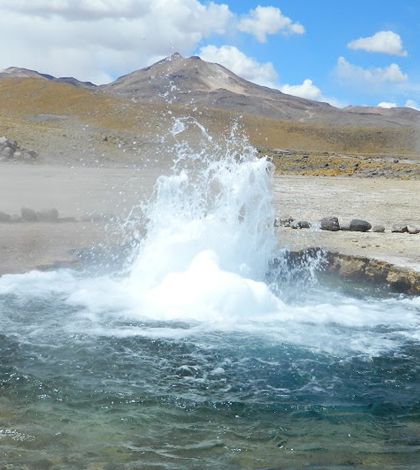UC Berkeley Scientists Instrument Geysers To Learn More About Volcanoes

A geyser studied by UC Berkeley scientists. (Credit: University of California, Berkeley)
Geysers are mysterious things. Locked underground in a series of loops and heated chambers, they hold water and steam that shoot out of the ground on their own. And beyond seeing that they yield such explosions, scientists have long wondered why erupting geysers exist in the first place. Why doesn’t a geyser simply run out of steam and bubble up into a hot spring instead?
Clearly some questions are harder to answer than others, and the one asking why geysers exist isn’t one that can be solved yet. But there are others that can be measured by scientific investigation, and researchers at the University of California, Berkeley have set out to answer them.
Around half of the world’s geysers can be found in Yellowstone National Park, and that’s where the UC Berkeley team surveyed. Investigations there relied on non-intrusive methods and equipment because Yellowstone is a protected area. To fill gaps in understanding left by the restrictions, they also traveled to a site near Chile’s Atacama Desert where it’s permitted to deploy instruments within geysers.
“Geysers are fascinating and millions of people watch them in Yellowstone each year,” said Michael Manga, professor of earth and planetary science at UC Berkeley. “They’re windows into how Earth transfers water and heat and we can study them at the surface.”
He and others at the university studied Yellowstone with above ground instruments like seismometers, tiltmeters and infrared cameras. In Chile, they strung temperature sensors and pressure transducers down geysers to study their internal dynamics. They also dropped GoPro cameras down into the spewing tubes to record the action.
Along the way, they uncovered some key finds about geysers that Manga says could help in understanding other types of eruptions, such as volcanoes that are much too large and dangerous to instrument in similar ways.

UC Berkeley scientists studied geysers to better understand how Earth transfers water and heat. (Credit: University of California, Berkeley)
“We’re interested in why and how volcanoes erupt. And for us, geysers are small versions of volcanoes,” said Manga. “We put a range of instruments inside. Those geysers we picked had holes big enough for cameras and probes. But we also took water samples.”
The water samples helped show what minerals are dissolved in geysers’ water, and researchers also tried out lidar and radar to measure how the ground around geysers deforms as they erupt. The real key measurements were pressure and temperature, says Manga, because the water boiling within is most controlled by heat and pressure.
Overall, the efforts helped scientists get a good look at heat and water transfer across a wide range of geyser types, yielding information that advances understanding of geysers but also adds to what is known about volcanoes.

Researchers run temperature and pressure sensors down a geyser in Chile. (Credit: University of California, Berkeley)
“Geysers are just erupting water. Volcanoes are more complicated because they erupt liquid rock with water in it,” said Manga. “But by measuring the eruption physics of geysers and combining those with what volcanoes do using geothermal technology, we can use the insights we gain on volcanoes.”
In addition to those insights, Manga and others uncovered new details into the inner workings of geysers and added to their understanding. At one site, they found that steam can escape a geyser at the speed of sound. At another, they measured how the ground deforms inside and outside of a geyser, leading them to conclude that there must be something special about the substrate that allows a geyser to exist.
They even found what causes a geyser to stop erupting: It runs out of steam, or cold groundwater rushes into it, causing its water to cease boiling. Geysers that are more exposed to the external environment — those that reside in open pools instead of cones — are more vulnerable to those types of disturbances, says Manga.
But perhaps the most striking find revealed how truly interconnected and regular geysers naturally are. In one test, researchers discovered a set of three geysers that erupted one after another in a well-timed sequence. In other tests, they saw how small eruptions steadily occurred as they built up to yield bigger ones.
In a similar vein, they found a geyser in Chile that erupted at exactly the same time interval over 3,600 eruptions, a regularity that is more precise than the eruptions of Yellowstone’s Old Faithful.
“We have a lab model that we can’t make as regular,” said Manga. “It’s a very simple model, while the real world is complicated and messy.”
Top image: A geyser studied by UC Berkeley scientists. (Credit: University of California, Berkeley)





0 comments